
|
Please beware, to register at venomland you are requested to use your full name (first and family name) - nicknames are not allowed and will be not activated! thx
Dear Venomland Members and Friends, Venomland is a little more than 6 years old now and by far the biggest Hot Snake community on the Planet! We want to thank all of you who made Venomland the leading Board. We are also very thankful to our Moderators and Admins for years of hard work. Now, it is time to move on. I have been thinking how to proceed and what to do with our beloved board as we reach a size, that we need to make drastic changes to secure the future of our community. As of now, Venomland is hosted by a free (well mostly free) hosting service. That was good for the first years but now we need to find a new way to run our forum. I have spend hundreds of Dollars over the years to keep Venomland up and running, and i have done so with pleasure. Now, we need your help! We need to come up with several thousand dollars for our Venomland 2.0 project, which i frankly cant pay for any longer by myself. So Venomland is asking his Friends and Members for the first time for their financial Support. Please help to keep Venomland alive, and let us move on to a new, better Portal in the Future! Every Dollar is helping us a great deal. I know, its hard times for everyone, but please spare a few Dollar for our community. If you have only 10 Dollars to spare, we are grateful, if it is more, it would be awesome. We are planning to develop a very new Venomland, with real community functions, a forum like you are already loving it and a real (online) Hot Snake Magazin. Also, there will be download areas for scientific papers, Wallpapers and more. Again folks, we can only do that if you all help. Please send me a Private Message if you want to keep Venomland alive, i will provide you with the details on how to donate Money. For now, we can accept money from creditcards via skrill (please google it, its a free service - account-details will be forwarded to you) and paypal. All the best, and for a (hopefully) nice future of our Board. Mario
|
| | | Micropechis ikaheka keepers? |  |
|
+4Fabian Dirks Peter Zürcher David Williams Marthinus C. Harmse 8 posters | | Author | Message |
|---|
Marthinus C. Harmse
Snakemaster



Number of posts : 254
Age : 42
Location : South-Africa
Points : 5852
Registration date : 2009-04-18
 |  Subject: Micropechis ikaheka keepers? Subject: Micropechis ikaheka keepers?  Sat 14 Nov - 7:52 Sat 14 Nov - 7:52 | |
| Hi guys.
I have been wondering about their habits and whether anyone has had any success with these in the past?
Are there any keepers with any experience with this species?
If so then please enlighten me.
Heres a quick extract which I enjoyed. Author: Mark O'Shea
Distribution: New Guinea.
Habitat: Coconut plantations and rainforests.
Diet: Lizards, snakes, small mammals, possibly also frogs.
Max.length: 1.2-1.7 m SVL (1.5-2.0 m TL).
Reproductive strategy: Oviparous, clutch size unknown.
The New Guinea small-eyed snake is a secretive nocturnal elapid with a striking patterning that ranges from red bands on a white background in juveniles, to buff or brown bands on a lighter brown background in adults. Bands are more numerous posteriorly, and the tail may be entirely dark. The head is usually grey, and the eyes are small. Small-eyed snakes bite plantation workers, grass-cutters and villagers. They encounter these snakes abroad at night or in the early morning, especially during the wet season. The snakes are easiest to find in the drier weather when they are hidden inside the coconut husk piles. | |
|   | | Guest
Guest
 |  Subject: Re: Micropechis ikaheka keepers? Subject: Re: Micropechis ikaheka keepers?  Sun 15 Nov - 11:50 Sun 15 Nov - 11:50 | |
| Love to see a pic. of one. |
|   | | David Williams
Newbie



Number of posts : 16
Age : 59
Location : Port Moresby, Papua New Guinea
Points : 5190
Registration date : 2010-03-21
 |  Subject: Re: Micropechis ikaheka keepers? Subject: Re: Micropechis ikaheka keepers?  Sun 21 Mar - 19:52 Sun 21 Mar - 19:52 | |
| Here are a couple we have kept in our research collection.  Adult from Oro Province 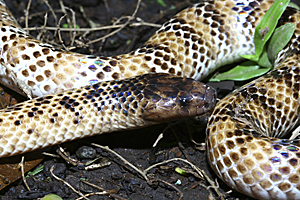 Adult from Madang Province 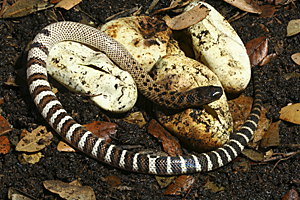 Captive bred hatchling, December 2006 These are not easy snakes to keep, they have very exact moisture requirements (they dehydrate easily in a dry cage/dry air/dry substrate), and are extremely hard to switch from snakes to rodents. That said we did breed them back in 2006, only the second captive breeding on record AFAIK. Cheers David | |
|   | | Peter Zürcher
Admin



Number of posts : 1266
Age : 72
Location : Carinthia, Austria
Points : 8126
Registration date : 2008-03-06
 |  Subject: Re: Micropechis ikaheka keepers? Subject: Re: Micropechis ikaheka keepers?  Sun 21 Mar - 20:05 Sun 21 Mar - 20:05 | |
| Thanks David!
Very interesting, never seen pictures of these....
And welcome to VenomLand - great to have you here!
Best regards
Peter | |
|   | | Fabian Dirks
Serpent Chief



Number of posts : 766
Age : 42
Location : Germany
Points : 6538
Registration date : 2009-01-07
 |  Subject: Re: Micropechis ikaheka keepers? Subject: Re: Micropechis ikaheka keepers?  Sun 21 Mar - 20:32 Sun 21 Mar - 20:32 | |
| - Quote :
- Very interesting, never seen pictures of these...
dito Really nice coloration rgds Fabian | |
|   | | David Williams
Newbie



Number of posts : 16
Age : 59
Location : Port Moresby, Papua New Guinea
Points : 5190
Registration date : 2010-03-21
 |  Subject: Re: Micropechis ikaheka keepers? Subject: Re: Micropechis ikaheka keepers?  Sun 21 Mar - 20:37 Sun 21 Mar - 20:37 | |
| Here are a couple more juvenile photos, not particularly good ones though I'm sorry to say ... still in the process of sorting my photographic library and migrating some of the better images to Photobucket, but I will post more photos (of these and various other species) as I get organized... 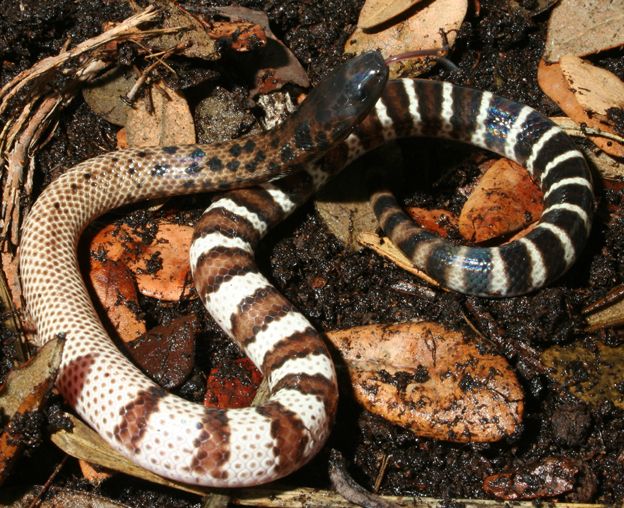 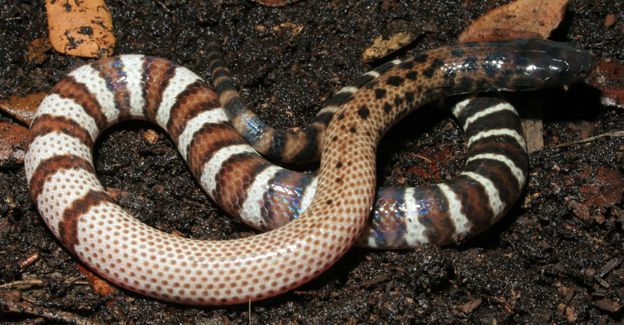 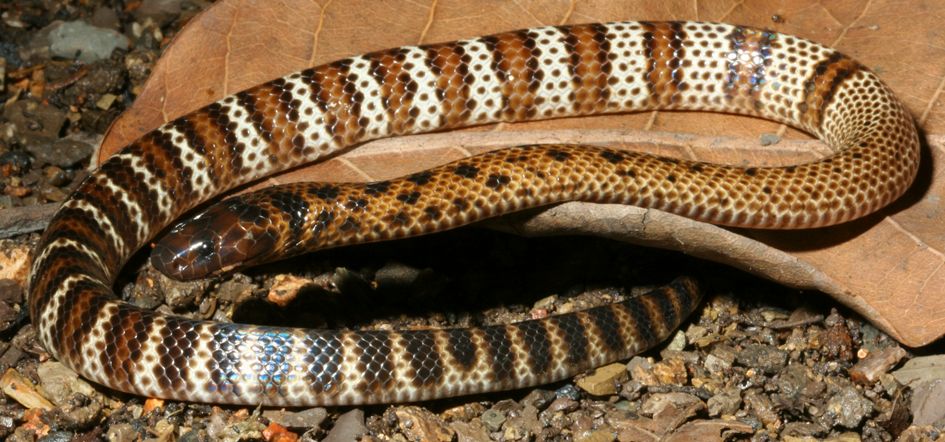 Captive bred juveniles from Madang Province, PNG Cheers David | |
|   | | Jaroslav Karhánek
Snakecharmer



Number of posts : 213
Age : 33
Location : Czech republic
Points : 5765
Registration date : 2009-04-14
 |  Subject: Re: Micropechis ikaheka keepers? Subject: Re: Micropechis ikaheka keepers?  Sun 21 Mar - 20:49 Sun 21 Mar - 20:49 | |
| Very nice and interesting snakes, the babies are very cool with lovely colour. Can you write to us more information about this snake, David? | |
|   | | NiekHofman
Snakekeeper



Number of posts : 83
Age : 46
Location : Eindhoven , Netherlands
Points : 5388
Registration date : 2009-12-15
 |  Subject: Re: Micropechis ikaheka keepers? Subject: Re: Micropechis ikaheka keepers?  Sun 21 Mar - 21:34 Sun 21 Mar - 21:34 | |
| I know a guy who keeps one..at least as far as I know he still has it. I shall send him a message so he can contact you if he desires to do so .. | |
|   | | David Williams
Newbie



Number of posts : 16
Age : 59
Location : Port Moresby, Papua New Guinea
Points : 5190
Registration date : 2010-03-21
 |  Subject: This is a review I wrote that is now about 3-4 years old ... Subject: This is a review I wrote that is now about 3-4 years old ...  Sun 21 Mar - 21:55 Sun 21 Mar - 21:55 | |
| Species Profile: New Guinean small-eyed snake (Micropechis ikaheka)
David Williams
Australian Venom Research Unit PNG Snakebite Project[1,2]
1 Department of Pharmacology, School of Medicine
University of Melbourne
2 School of Medicine & Health Sciences
University of Papua New Guinea
INTRODUCTION
The forests of New Guinea are home to several species of venomous snakes that are endemic only to Papua New Guinea, West Papua and the Solomon Islands. These mostly crepuscular snakes include several species of small fossorial serpents in the genus Toxicocalamus; the spectacularly colourful Solomon’s small-eyed snake (Loveridgelaps elapoides); secretive Solomon’s coral snake (Salomonelaps par); and the wide-ranging highly venomous New Guinea small-eyed snake (Micropechis ikaheka). This last snake is a significant cause of snakebite in some parts of northern Papua New Guinea, yet remains poorly known to scientists and local villagers alike.
PHYSICAL DESCRIPTION AND IDENTIFICATION
Body shape and geometry
This is a thick-bodied, powerfully muscled snake with a flat, broad head, and, as the name implies, the characteristically small, recessed eyes of typical fossorial species. The head is distinct from the neck in smaller specimens, but this is less pronounced in heavily muscled larger snakes. The body is cylindrical and the scales are smooth.
Body size
The average total length has been reported to be 1.2-1.4 metres with a maximum length of up to 2.1 metres[1]; however a specimen collected near the Gogol River south of Madang in 1995 measured 2.3 metres in total length. The mean length of five specimens measured in the National Museum and Art Gallery collection was 1444 ± SE 89.7 mm (range: 1285-1785 mm).
Body colouration
Micropechis ikaheka has an extremely variable colour pattern that is essentially based on a greyish head and pale yellow, creamish or salmon coloured body with dark-tipped scale edges that give rise to broad dark bands from midbody to the end of the tail. Juvenile snakes are much more prominently marked than adults suggesting that colour and pattern fades with age. In the Madang Province and particularly on Karkar Island where the species is especially common it is often known colloquially as the ‘white snake’ due to its pale body colour.
Scalation
Midbody dorsal scale rows are in 15 rows; ventrals number 178-225; and the anal plate is divided as are the 36-55 subcaudals under the tail.
DISTRIBUTION AND HABITAT DATA
Distribution in Papua New Guinea
Recorded from northern Western Province (Kiunga to Star Mountains) and through all of the Highland and New Guinea Provinces with isolated records from Gulf and Central provinces. The species is the most well-known on Karkar Island off the coast of Madang and there are many records from villages such as Mom, Kurum, Miak, Kulkul, Kaviak, Bulu and from around the Gaubin Lutheran Mission. There are also numerous records from the nearby mainland including Madang Township, Alexishafen, Malolo, Nageda and Bogia. It is probable that the snake is found on Manam Island off Bogia. Further along the coast it is common near Wewak and Aitape and occurs on Walis Island.
Small-eyed snakes are also common around Popondetta, Buna, Kokoda and Ilimo in Oro Province, and at Garaina, Wau and Bulolo in Morobe province. There are also multiple records from Telefomin (1500 metres above sea level) and at Tabubil, Ningerum, Rumginae, Takam and Munbil in Western province. Records are scattered throughout the rest of the Highlands and New Guinea provinces but this may be due more to the crepuscular nature of the snake than to a lack of abundance.
Distribution outside Papua New Guinea
This species is widely distributed in West Papua with reports from as far afield as Montagne de Karoon on the north-western side of Waigao Island to Jayapura near the Papua New Guinea border in the east of West Papua province. There are museum records from Batante Island and from Misool Island north of Seram. In Geelvink Bay small-eyed snakes have been found on Jobi and Numfoor Islands and it also occurs on Mansinam Island off the eastern coast of Sorong. Mainland records include the mountainous Baliem Valley, Wasior on the Wandammen Peninsula, Fakfak on the Onim Peninsula, and Mimika River and Merauke in the south. There are also reports of specimens from the Aru Islands.
Habitat preferences
This species live a mainly terrestrial existence on the floors of forests and plantations throughout its range. Specimens have been found from near sea level to altitudes of more than 1500 metres, and the species appears to tolerate the conditions in cool, wet mountain forests very well. It is crepuscular and spends most of its time either hidden under ground debris or foraging among leaf litter. Specimens are common in monsoonal forests, lowland swamps and in both lowland and montane rainforests. There are abundant regional populations concentrated in areas with large Cocoa plantations, particularly Karkar Island, Kokoda, Aitape and Wewak. The coconut harvesting process results in the creation of large ‘coconut husk piles’; large piles of decomposing dried coconut husks left over after the nuts are removed, and these present both a haven to small-eyed snakes and a hazard to local plantation workers.
BIOLOGICAL AND BEHAVIOURAL DATA
Dietary preferences
Captive small-eyed snakes feed readily on lizards and frogs, and can be ‘encouraged’ to accept rodents with minimal difficulty. In the wild they share habitats with numerous species of small skinks, frogs, rodents and other snakes, and it has been reported that they will eat almost anything they encounter1. Large small-eyed snakes will eat smaller conspecifics without hesitation, and it may be that wild snakes are routinely cannibalistic.
Reproduction
A female M. ikaheka less than 1 metre in length produced 5 eggs in September 2006 after a mating in June of the same year. At the time of writing (November, 2006) these eggs have not yet hatched.
Activity data
During the dry season this snake is a common inhabitant of coconut husk piles on Karkar Island but appears to disperse from these into neighbouring forest during the wet season1. On the mainland snakes living in natural forest are rarely encountered and nothing is really known about their daily or seasonal activity cycles. During the wet season snakes are often encountered moving across roads and bush tracks at night, often well into the early hours of the morning.
Behaviour
Small-eyed snakes are shy and inoffensive until disturbed. If handled or stepped on they are very defensive and bite readily, often chewing down hard and refusing to let go again. Small specimens are very agile and surprisingly fast. Although generally considered to be a ground dwelling largely nocturnal species, there is a single report from West Papua of a serious snakebite having been caused by a large Micropechis ikaheka that was caught in a bird trap high in a tree2. The small eyes and smooth body scales are specific adaptations for foraging among the ground debris and loose topsoil in which the snake spends the majority of its life. Snakes collected inside coconut husk piles are rarely inactive, and this suggests that although the snake is rarely seen in the open during daylight it is active among the ground debris during this time.
VENOM COMPOSITION AND TOXICITY
As is the case with the Papuan blacksnake (Pseudechis papuanus), the availability of live small-eyed snakes (Micropechis ikaheka) from wildlife dealers in Papua and Indonesia has resulted in the recent characterization of some major venom components by overseas researchers[3-11]. The venom has strong neurotoxic, myotoxic, anticoagulant, platelet aggregation inhibiting and insulin-secretion stimulating activities. In patients bitten by this species neurotoxicity and myotoxicity appear to be the major clinical consequences[2,12-14]. Two cases in which patients had incoagulable blood have been attributed to powerful anticoagulant rather than procoagulant activity[12]; however researchers in Singapore recently isolated Mikarin, a single-chain metalloproteinase of 47 kDa[3]. Mikarin is unique compared to all other Australo-papuan snakes in being a Ca2+-independent prothrombin activator, and is the first Group I prothrombin activator to be found in elapid venom. A novel non-haemolytic, haemoglobinuria-inducing toxin (MiPLA-1), which is a 14 kDa, 124 amino acid residue PLA2, has been identified, and shown to also strongly inhibit collagen-induced platelet aggregation, as well as being potently myotoxic and anticoagulant[4]. It has been suggested that this toxin might produce haemoglobinuria by causing kidney leakage via either a direct or indirect nephrotoxic mechanism. MiPLA-1 is unique among snake venom PLA2s in that it is one of only a few to possess a ‘pancreatic loop’ region which has a major role in toxin conformation and hydrolytic activity. Several ‘short-chain’ and ‘long-chain’ postsynaptic neurotoxins with molecular weights of 6-8 kDa have also been isolated from Micropechis ikaheka venom[5-8]. One of these, Mikatoxin, has been found to produce neuromuscular paralysis through irreversible nicotinic AChR antagonism[8]. As well as these, an 11 kDa venom fraction containing a ‘long-chain’ neurotoxin also inhibited ADP-induced platelet aggregation[9]. The anticoagulant activity of Micropechis ikaheka venom is underpinned by the presence of a 17 kDa PLA2 toxin that inhibits both endothelial and platelet-induced procoagulation[9]. Three additional PLA2 toxins exhibit myotoxicity, anticoagulant activity and stimulate insulin secretion[7]. While the myotoxicity and anticoagulant activity were induced by the enzymatic actions of the toxins, the stimulation of insulin secretion was independent of enzymatic activity.
MEDICAL IMPORTANCE
Bites by small-eyed snakes appear to uncommon on the mainland of Papua New Guinea, but one study found that approximately 40% of envenomations on Karkar Island could be attributed to bites by Micropechis ikaheka[2]. At Madang on the mainland only 8.7% of bites were caused by this species; the remainder were caused by death adders (Acanthophis spp.)[14]. In the Kikori district of Gulf province small-eyed snakes are said by villagers to be quite common, and photographs of this snake were recognised by many people at Omati, Baina, Komaio and Karoulti. These villagers were adamant however that the snake did not bite people, and said that all of the snakebites in their region were caused by death adders.
ANTIVENOM
There is no specific antivenom available for treating bites by this species, although there are reports that CSL tiger snake and CSL blacksnake antivenoms may be beneficial[11,13]. A recent study found that while blacksnake antivenom neutralised the neurotoxicity induced by small-eyed snake venom, it was less effective at negating cardiovascular and haemotoxic effects[11]. CSL polyvalent antivenom was the most effective at neutralising all of the effects of this venom, and is currently recommended for treatment of human envenomation. Priority is being given to determining the binding efficacy of current antivenoms to specific toxins in Micropechis ikaheka venom.
REFERENCES
1. O’SHEA MT. (1996) A Guide to the Snakes of Papua New Guinea. Independent Publishing Limited, Port Moresby, PNG
2. WARRELL DA., HUDSON BG, LALLOO DG, et al., (1996) The emerging syndrome of envenoming by the New Guinea small-eyed snake Micropechis ikaheka. QJM. 89:523-30.
3. GAO R, KINI RM, GOPALAKRISHNAKONE P. (2002) A novel prothrombin activator from the venom of Micropechis ikaheka: isolation and characterization. Arch Biochem Biophys. 408(1):97-92.
4. GAO R, KINI RM, GOPALAKRISHNAKONE P. (1999) Purification, properties, and amino acid sequence of a hemoglobinuria-inducing phospholipase A(2) MiPLA-1, from Micropechis ikaheka venom. Arch Biochem Biophys. 369(1):181-92.
5. VINCENT A, OO S-L, RANG S. (1995) Identification of neurotoxic activities and preliminary fractionation of the New Guinean small-eyed snake (Micropechis ikaheka). Toxicon. 33(5):586.
6. GEH SL, VINCENT A, RANG S. (1997) Identification of phospholipase A2 and neurotoxic activities in the venom of the New Guinean small-eyed snake (Micropechis ikaheka). Toxicon. 35(1):101-9.
7. GAO R, KINI RM, LI G, et al. (2001) Purification and properties of three new phospholipase A2 isoenzymes from Micropechis ikaheka venom. Biochem et Biophys Acta. 1545(1-2):30-40.
8. NIRTHANAN SR, GAO P, GOPALAKRISHNAKONE P, et al. (2002) Pharmacological characterization of mikatoxin, an alpha-neurotoxin isolated from the venom of the New-Guinean small-eyed snake Micropechis ikaheka. Toxicon. 40(7):863-71.
9. SUNDELL IB, THEAKSTON RD, KAMIGUTI AS et al. (2001) The inhibition of platelet aggregation and blood coagulation by Micropechis ikaheka venom. Br J Haematol. 114(4):852-60.
10. KAMIGUTI AS, TREWEEKE AT, LOWE GM, et al. (1995) Platelet and neutrophil function inhibition by Micropechis ikaheka (small-eyed snake) venom: role of phospholipase A2. Toxicon. 33(3):275
11. TIBBALLS J, KURUPPU S, HODGSON WC, et al. (2003) Cardiovascular, haematological and neurological effects of the venom of the Papua New Guinean small-eyed snake (Micropechis ikaheka) and their neutralisation with CSL polyvalent and black snake antivenoms. Toxicon. 42(6):647-55.
12. HUDSON, BJ. (1988b) The small-eyed snake (Micropechis ikaheka): a review of current knowledge. PNG Med J. 31(3):173-8.
13. BLASCO P, HORNABROOK RW. (1972) A neglected but potentially dangerous New Guinea snake - the small eyed snake (Micropechis ikaheka). PNG Med J. 15(3):155-156.
14. HUDSON BJ, POMAT K. (1988) Ten years of snake bite in Madang Province, Papua New Guinea. Trans R Soc Trop Med & Hyg. 82(3):506-8. | |
|   | | Christoph Studer
Snakekeeper



Number of posts : 80
Age : 49
Location : Switzerland
Points : 5726
Registration date : 2009-01-16
 |  Subject: Re: Micropechis ikaheka keepers? Subject: Re: Micropechis ikaheka keepers?  Mon 22 Mar - 2:24 Mon 22 Mar - 2:24 | |
| Hy David
Thanks for posting this article.
This Snakes are truly beautiful-absolut fantastic!
Wish you a good time here.
Christoph | |
|   | | Jason Bruno
Snakecharmer



Number of posts : 142
Age : 47
Location : West Virginia
Points : 5436
Registration date : 2009-12-06
 |  Subject: Re: Micropechis ikaheka keepers? Subject: Re: Micropechis ikaheka keepers?  Mon 22 Mar - 6:00 Mon 22 Mar - 6:00 | |
| Very cool and interesting. Thanks for sharing with us and welcome. | |
|   | | Sponsored content
 |  Subject: Re: Micropechis ikaheka keepers? Subject: Re: Micropechis ikaheka keepers?  | |
| |
|   | | | | Micropechis ikaheka keepers? |  |
|
Similar topics |  |
|
| | Permissions in this forum: | You cannot reply to topics in this forum
| |
| |
| |
|













